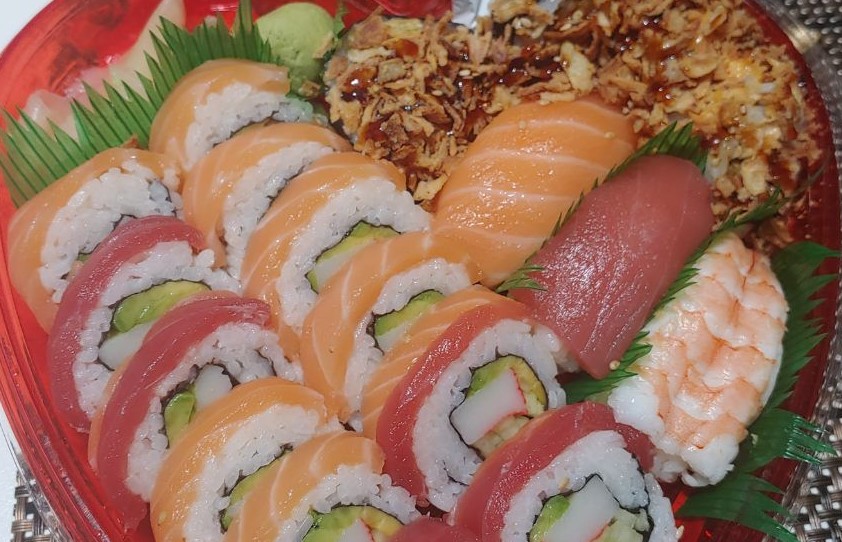Sushi, an ancient Japanese culinary art form, has transcended its cultural origins to become a beloved global delicacy. This delectable dish, comprising vinegared rice, fresh seafood, and a medley of complementary ingredients, is an epitome of precision, balance, and culinary finesse. Originating in Southeast Asia over a thousand years ago, sushi has evolved from a simple method of food preservation to a revered culinary tradition.
Its popularity stems not only from its exquisite taste but also from the delicate craftsmanship and mastery required to create it.

The roots of sushi can be traced back to ancient Southeast Asia, where people utilized fermented rice as a method of preserving fish. Over time, this preservation technique evolved into what we now recognize as sushi. The practice gradually migrated to Japan in the 8th century, accompanied by Chinese cultural influence. In Japan, sushi underwent significant transformation, with the introduction of vinegar to the rice, which not only enhanced its flavor but also accelerated the fermentation process. By the Edo period (1603-1868), sushi had transitioned from a method of preservation to a delectable culinary art form, finding its place in Japanese cuisine and culture.
In the 20th century, with advancements in transportation and globalization, sushi transcended its Japanese origins to captivate palates around the world. Its popularity surged in the United States during the mid-20th century, spurred by the innovative creations of chefs like Ichiro Mashita and the establishment of sushi bars in Los Angeles. The introduction of the California Roll, a maki roll with avocado, crab, and cucumber, played a pivotal role in making sushi more accessible to Western tastes. Today, sushi has become a ubiquitous presence in cities worldwide, reflecting its universal appeal and adaptability.
The Culinary Craftsmanship of Sushi
Becoming a sushi chef, known as an Itamae in Japan, is a journey marked by dedication, discipline, and a lifelong pursuit of mastery. This revered culinary profession demands years of rigorous training and apprenticeship under the guidance of a master sushi chef. Aspiring Itamae typically embark on this path at a young age, often in their late teens or early twenties, entering an apprenticeship known as “shokunin kōkō.” Here, they learn the fundamental skills of sushi preparation and gain hands-on experience in a sushi restaurant.
The foundation of sushi-making lies in the proper preparation of sushi rice, a skill that apprentices dedicate considerable time to perfecting. It is crucial that the rice achieves the ideal texture, flavor, and consistency. Additionally, mastery of knife skills is paramount for an Itamae. They must become adept at handling sharp, precise blades to ensure clean, precise cuts of fish, vegetables, and other ingredients.
An Itamae’s keen eye for selecting the freshest and highest-quality seafood is a critical aspect of their training. They learn to handle fish and shellfish with the utmost care to maintain its flavor and texture. Crafting nigiri, which involves hand-pressing rice topped with fish, and creating visually appealing and flavorful sashimi, thinly sliced raw fish, become central aspects of their skill set.
Achieving a delicate balance between rice and fish is a hallmark of skilled sushi-making. Itamae must master the art of seasoning, ensuring that the rice is perfectly balanced with the flavors of the fish and any accompanying ingredients. Even after achieving the status of an Itamae, the learning process never truly ends. Sushi chefs are encouraged to seek out new experiences, ingredients, and techniques to continually refine their craft.
Tools of labor
Sushi knives, known as “hocho,” are considered sacred tools for a sushi chef. These knives are meticulously crafted, often by skilled artisans, using specialized techniques and high-quality materials. There are several reasons why sushi knives are so highly cherished. Firstly, they are honed to a razor-sharp edge, allowing for precise cuts that preserve the integrity of the ingredients. A well-crafted sushi knife is balanced and comfortable to hold, allowing the chef to work with precision and control. Different types of sushi knives serve specific purposes, such as slicing sashimi or crafting intricate cuts. Each knife is designed to excel in its intended use. Sushi knives often carry a deep cultural significance. They may be family heirlooms, passed down through generations of sushi chefs, symbolizing the continuation of a cherished culinary tradition.
The process of crafting a sushi knife is a labor of love, involving skilled craftsmanship and attention to detail. Many knives are handmade, reflecting the artisan’s dedication to their craft. A well-maintained sushi knife can last a lifetime and beyond, with some chefs considering their knives to be a lifelong companion in their culinary journey. In Japanese culinary culture, the relationship between a sushi chef and their knife is one of profound respect and reverence. The knife becomes an extension of the chef’s skill and artistry, representing the culmination of years of training and dedication. Together, the skilled Itamae and their cherished knives create the exquisite and delicate world of sushi, an art form that continues to captivate palates around the globe.
Sushi creation
Creating exceptional sushi requires a meticulous blend of skill, precision, and an understanding of flavor profiles. The core elements of sushi-making encompass:
Sushi Rice Preparation: The foundation of any sushi dish is the rice. It must be cooked to perfection, seasoned with a delicate balance of rice vinegar, sugar, and salt to achieve the ideal texture and flavor.
Knife Skills: Sushi chefs, known as Itamae, undergo rigorous training to master the art of knife work. A sharp, precise blade is essential for cutting fish and other ingredients with finesse.
Seafood Selection and Handling: The quality of the seafood is paramount. It must be impeccably fresh, handled with care, and sourced sustainably. This expertise ensures the safety and exceptional taste of the final dish.
Nigiri Assembly: Crafting nigiri, a hand-pressed mound of rice topped with a slice of fish or other ingredients, demands a delicate touch to achieve a harmonious balance of flavors and textures.
Maki Rolling: Creating visually appealing and flavorful maki rolls requires adeptness in the art of rolling, ensuring that the ingredients are evenly distributed within the seaweed wrapper.
Why Some Sushi is Super Expensive
The price range of sushi is notably diverse and is influenced by several key factors. Particularly expensive sushi often owes its premium cost to various elements: Firstly, the quality of ingredients plays a pivotal role. Rare or exotic components, such as prized cuts of toro (fatty tuna) or uni (sea urchin), significantly contribute to the overall cost. Furthermore, the freshness and seasonality of the ingredients are crucial determinants. Acquiring the freshest produce, especially those that are seasonal or challenging to obtain, can lead to higher expenses in crafting the sushi. Another influential factor is the expertise and reputation of the sushi chef. Renowned chefs known for their exceptional skills and the ability to craft extraordinary sushi often command higher prices, reflecting their culinary artistry. Additionally, the location and ambiance of the sushi establishment can impact the price point. Sushi served in upscale, high-end settings in prime locations tends to be more expensive due to the premium dining experience and environment offered to patrons. These factors collectively contribute to the varying costs of sushi, making it an experience that caters to a wide range of tastes and preferences.
The Art of Discerning Good Sushi
Discerning exceptional sushi from the ordinary is a culinary pursuit that demands an understanding of various nuanced factors. These elements collectively contribute to the overall quality of the sushi, elevating it to a level of culinary excellence. First and foremost, the texture and freshness of the fish are paramount. The fish should exhibit a delicate tenderness, providing a satisfying mouthfeel without being overly chewy. Additionally, it should exude a clean, briny freshness, acting as a testament to its quality and indicating that it was sourced and handled with meticulous care. Furthermore, achieving a harmonious balance of flavors is a hallmark of exceptional sushi. This delicate equilibrium involves ensuring that the rice complements the fish and any accompanying ingredients. The rice serves as the foundation, acting as a canvas to enhance the natural flavors of the fish without overwhelming them. This delicate interplay of tastes results in a sushi experience that is both nuanced and exquisite. Subtlety in seasoning is another crucial aspect of exceptional sushi. The rice should be delicately seasoned, with the seasonings enhancing the overall taste without overpowering the delicate flavors of the fish. Achieving this nuanced balance requires a deep understanding of ingredients and a refined palate, allowing the sushi chef to enhance the natural essence of each component. The visual presentation of sushi is a testament to the chef’s dedication and attention to detail. Exceptional sushi is not only a delight to the palate but also a feast for the eyes. The artful arrangement of colors, textures, and shapes showcases the chef’s craftsmanship, turning each plate into a work of culinary art. A visually appealing presentation not only enhances the overall dining experience but also reflects the care and passion invested in crafting each piece of sushi.
Homemade Tekka Maki
To make your own tuna roll, known as Tekka Maki, start by preparing the sushi rice. Rinse 1 cup of sushi rice under cold water until it runs clear, then cook it according to the package instructions and let it cool slightly. In a separate bowl, mix 2 tablespoons of rice vinegar, 1 tablespoon of sugar, and 1 teaspoon of salt, then gently heat this mixture in the microwave for about 30 seconds to dissolve the sugar and salt. Fold the vinegar mixture into the warm rice and let it cool completely. Ensure you have sashimi-grade tuna for safe consumption of raw fish, and cut it into long strips that will fit within the width of the nori sheet. Place a sheet of nori on a bamboo rolling mat, shiny side down, and wet your hands slightly to prevent the rice from sticking. Spread a handful of sushi rice evenly over the nori, leaving a small border at the top edge. Lay the strips of tuna along the center of the rice-covered nori. Using the bamboo mat, carefully roll up the sushi, applying gentle pressure to compact the roll. Once rolled, use the bamboo mat to shape and tighten the roll. With a sharp knife slightly moistened with water, slice the roll into bite-sized pieces and arrange them on a plate. Serve the tuna rolls with soy sauce for dipping, and include wasabi and pickled ginger for added flavor. Remember, practice makes perfect, so don’t be discouraged if your first attempts aren’t flawless. Enjoy your homemade tuna rolls!






